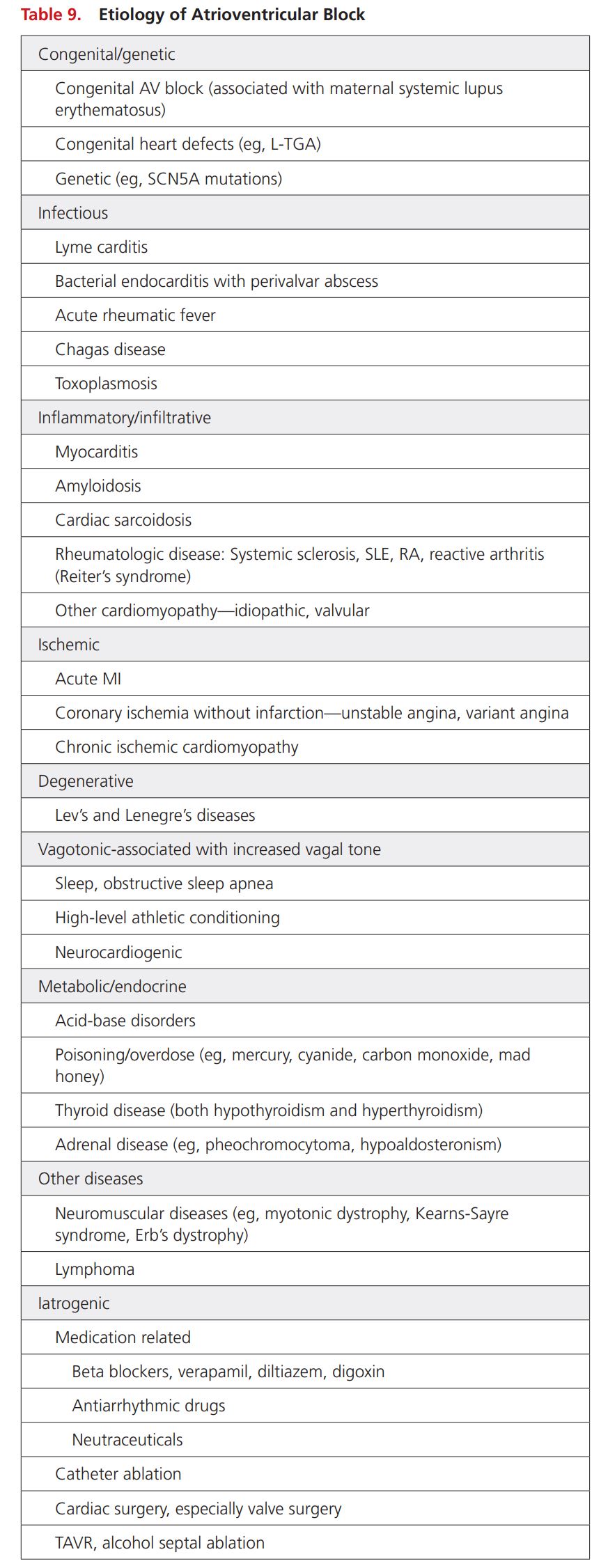Paroxysmal AV Block Etiology: Difference between revisions
Jump to navigation
Jump to search
No edit summary |
No edit summary |
||
| Line 12: | Line 12: | ||
[[Image:Etiology of AV Block.JPG|thumb|center|500px| Etiology of AV Block<ref name="pmid30412710">{{cite journal| author=Kusumoto FM, Schoenfeld MH, Barrett C, Edgerton JR, Ellenbogen KA, Gold MR | display-authors=etal| title=2018 ACC/AHA/HRS Guideline on the Evaluation and Management of Patients With Bradycardia and Cardiac Conduction Delay: Executive Summary: A Report of the American College of Cardiology/American Heart Association Task Force on Clinical Practice Guidelines, and the Heart Rhythm Society. | journal=J Am Coll Cardiol | year= 2019 | volume= 74 | issue= 7 | pages= 932-987 | pmid=30412710 | doi=10.1016/j.jacc.2018.10.043 | pmc= | url=https://www.ncbi.nlm.nih.gov/entrez/eutils/elink.fcgi?dbfrom=pubmed&tool=sumsearch.org/cite&retmode=ref&cmd=prlinks&id=30412710 }} </ref>]] | [[Image:Etiology of AV Block.JPG|thumb|center|500px| Etiology of AV Block<ref name="pmid30412710">{{cite journal| author=Kusumoto FM, Schoenfeld MH, Barrett C, Edgerton JR, Ellenbogen KA, Gold MR | display-authors=etal| title=2018 ACC/AHA/HRS Guideline on the Evaluation and Management of Patients With Bradycardia and Cardiac Conduction Delay: Executive Summary: A Report of the American College of Cardiology/American Heart Association Task Force on Clinical Practice Guidelines, and the Heart Rhythm Society. | journal=J Am Coll Cardiol | year= 2019 | volume= 74 | issue= 7 | pages= 932-987 | pmid=30412710 | doi=10.1016/j.jacc.2018.10.043 | pmc= | url=https://www.ncbi.nlm.nih.gov/entrez/eutils/elink.fcgi?dbfrom=pubmed&tool=sumsearch.org/cite&retmode=ref&cmd=prlinks&id=30412710 }} </ref>]] | ||
==References== | |||
Revision as of 08:53, 26 June 2020
Overview
Intrinsic conduction/ structural defects particularly those located in this intra His Bundle (intrinsic AV block), low adenosine levels (idiopathic AV block) and increase vagal tone/vagal surge (extrinsic AV block) are the major causes of paroxysmal AV block. However, several reversible causes need to be ruled out before coming to a diagnosis.
Etiology
- Intrinsic conduction/ structural defects particularly those located in this intra His Bundle (intrinsic AV block), low adenosine levels (idiopathic AV block) and increase vagal tone/vagal surge (extrinsic AV block) are the major causes of paroxysmal AV block.
- However, some studies have shown an association of AV nodal blocking agents (beta blockers, calcium channel blockers), degenerative valvular heart disease, degeneration of the conduction system (the His bundle in particular), acute coronary syndromes (inferior /anterior wall myocardial infarction in particular) and paroxysmal AV block.
- Less common causes that have been cited are Lev- Lenegre disease, aneurysmal membranous septum, rheumatic heart disease, mitral valvulitis, sarcoidosis, h/o surgery and infective endocarditis with abscess formation. [1]
- A study of 20 patients conducted by Zabarski et al found that ischemic heart disease, dilated cardiomyopathy, carotid sinus hypersensitivity, chronic AV blocker consumption and aortic valve replacement were associated paroxysmal AV block.[2]
2018 ACC/AHA/HRS Guideline on the Evaluation and Management of Patients With Bradycardia and Cardiac Conduction Delay: Etiology of AV Block

References
- ↑ Guerrero-Márquez FJ, Arana-Rueda E, Pedrote A (2016). "Idiopathic Paroxysmal Atrio-Ventricular Block. What is The Mechanism?". J Atr Fibrillation. 9 (3): 1449. doi:10.4022/jafib.1449. PMC 5368548. PMID 28496928.
- ↑ Shohat-Zabarski R, Iakobishvili Z, Kusniec J, Mazur A, Strasberg B (2004). "Paroxysmal atrioventricular block: clinical experience with 20 patients". Int J Cardiol. 97 (3): 399–405. doi:10.1016/j.ijcard.2003.10.023. PMID 15561325.
- ↑ Kusumoto FM, Schoenfeld MH, Barrett C, Edgerton JR, Ellenbogen KA, Gold MR; et al. (2019). "2018 ACC/AHA/HRS Guideline on the Evaluation and Management of Patients With Bradycardia and Cardiac Conduction Delay: Executive Summary: A Report of the American College of Cardiology/American Heart Association Task Force on Clinical Practice Guidelines, and the Heart Rhythm Society". J Am Coll Cardiol. 74 (7): 932–987. doi:10.1016/j.jacc.2018.10.043. PMID 30412710.